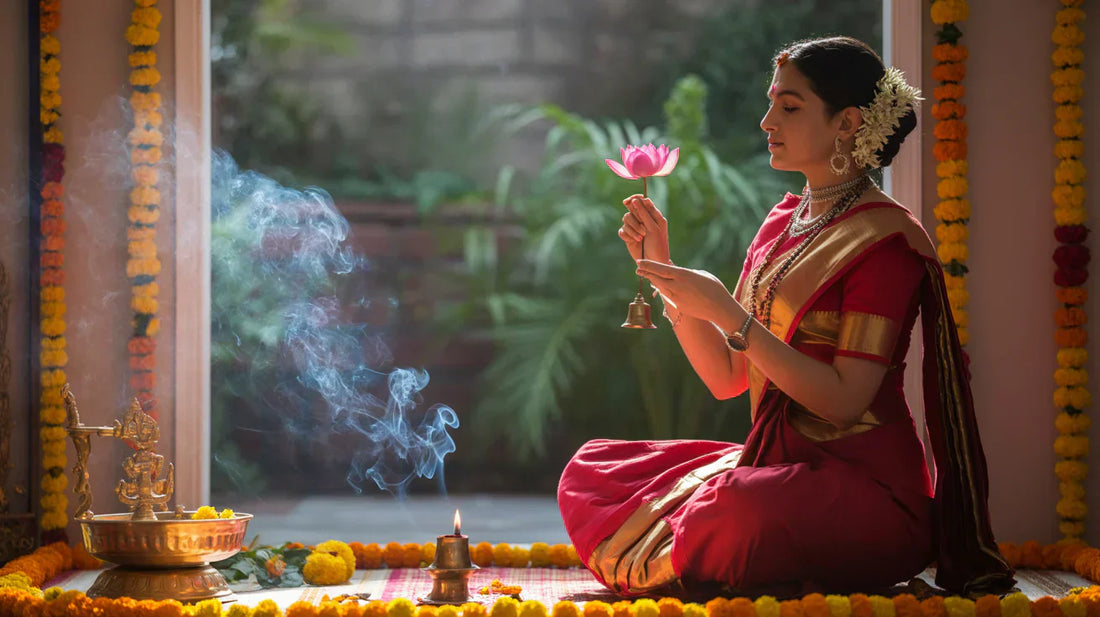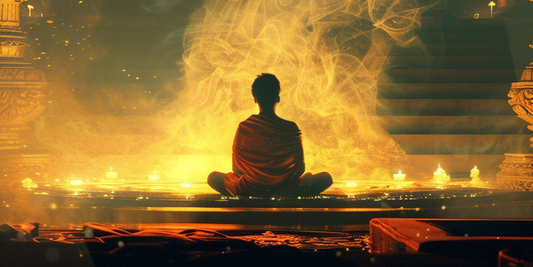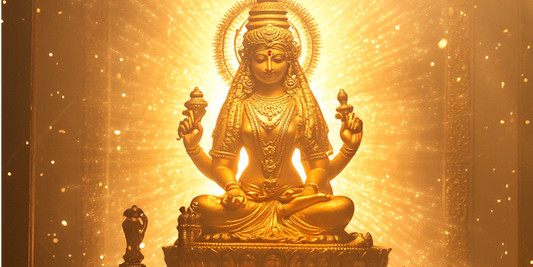
The Nine Forms of Nav Durga: Names, Significance, and Benefits
During Navratri, devotees perform Nav Durga Sadhana, dedicating each day to a form of Adya Shakti (Ma Durga). The practice involves morning and evening rituals.
In the morning, devotees perform a yagna (fire offering) to honour the goddess, while in the evening, they chant specific mantras associated with the day's Devi form. This sadhana requires setting aside approximately forty-five minutes in the morning and nine minutes in the evening for japa for nine consecutive days.
Nav Durga Sadhana invokes the blessings of the Divine Mother, filling devotees' lives with courage and strength. It offers an opportunity to purify oneself and progress on the spiritual path.
1st Day of navratri - Ma Shailaputri
Initially, Lord Brahma sought to populate the universe and created the Prajapatis, Manus, and Rishis for this purpose. Among them, Daksha, a distinguished Prajapati, played an important role. With his devotion and penance, he pleased Ma Adi Shakti, who gave him the blessing that she would be born as his daughter. As a result of this boon, Goddess Sati manifested on earth.
Read here about the birth of Devi as Sati, her sacrifice, and then re-birth as Devi Shailaputi.
Benefits of Worshipping Ma Shailaputri
Worshipping Ma Shailaputri on the first day of Navratri grants these blessings:
- Prosperity and Abundance
- Spiritual Awakening
- Emotional Stability
- Protection
- Fulfillment of Desires
2nd Day of Navratri - Devi Brahmacharini
Ma Brahmacharini, the second manifestation of Devi Durga. She is the ascetic form of Ma Parvati, who performed intense penance to win Lord Shiva's affection. Ma Brahmacharini signifies strength, determination, and the pursuit of wisdom.
Benefits of Worshipping Ma Brahmacharini
Worshipping Ma Brahmacharini on the second day of Navratri brings these blessings:
- Strength and determination
- Spiritual growth
- Inner peace
- Wisdom and knowledge
- Fulfillment of aspirations
3rd Day of Navratri - Devi Chandraghanta
Devi Chandraghanta, the third form of Durga, is honoured on the third day of Navratri. She embodies serenity and strength.
In her ten hands, she holds various weapons such as a lotus, arrow, bow, and trident. She wears a half-moon on her forehead.
Benefits of Worshiping Ma Chandraghanta
Worshipping Ma Chandraghanta on the third day of Navratri brings these blessings:
- Protection and courage
- Spiritual growth
- Marital bliss
4th Day of Navratri - Devi Kushmanda
On the fourth day of Navaratri, we honour Devi Kushmanda, another beautiful form of Goddess Durga. Ma Kushmanda is the creator of the entire universe, having brought it into existence with her soft smile.
The name itself signifies a ‘cosmic egg of energy,’ representing the immense creative power associated with her. Ma Kushmanda is depicted with eight hands holding different weapons, and rosary beads.
She is Adi Swaroopa, the primordial mother. With her merciful look and gentle smile, she blesses her devotees with creativity, intelligence and energy.
Benefits of Worshipping Ma Kushmanda
Worshipping Ma Kushmanda on the fourth day of Navaratri brings these blessings:
- Enhanced creativity and iIntelligence
- Positivity and energy
Devotees believe that invoking Ma Kushmanda’s compassionate gaze leads to courage, and determination to overcome challenges.
5th Day of Navratri - Devi Skandamata
Ma Skandamata, the fifth form of Ma Durga signifies the balance of wisdom (Gyana-Shakti) and action (Kriya-Shakti). She embodies the role of a nurturer, who also possesses immense strength to protect her devotees and bring peace to the world.
Benefits of Worshipping Ma Skandamata
Worshipping Ma Skandamata on the fifth day of Navaratri brings these blessings:
- Protection and Inner Strength
- Spiritual Growth and Peace
6th Day of Navratri - Devi Katyayani
On the sixth day of Navaratri, we honor Goddess Durga as Devi Katyayani. She is depicted with three eyes and four hands, holding a sword and a lotus, while offering blessings with her other two hands. She embodies strength and courage.
Blessings of Worshipping Ma Katyayani
Worshipping Ma Katyayani on the sixth day of Navratri Navaratri brings these blessings:
- Strength to overcome obstacles
- Success in endeavours
- Fulfillment of desires
Ma Katyayani inspires confidence, inner strength, and positivity in her devotees, guiding them to achieve their goals and lead fulfilling lives.
7th Day of Navratri - Devi Kalratri
On the seventh day of Navratri, we honour Goddess Durga as Kalaratri. Kalaratri, meaning ‘the night of darkness,’ is depicted with a dark complexion and is known for her fierce and protective nature.
She has four hands: two holding a scimitar and a torch, and the other two held in Abhaya and Varada Mudras.
Benefits of Worshipping Ma Kalaratri
Worshipping Ma Kalaratri on the seventh day of Navratri brings these blessings:
- Eliminates fears and obstacles
- Removes ignorance and provides enlightenment
- Spiritual awakening
- Personal transformation
8th Day of Navratri - Devi Maha Gauri
On the eighth day of Navaratri, we honor Ma Durga as Devi Mahagauri. She symbolises purity and peace and is depicted with four arms: two holding a trident (Trishul) and a drum (Dhamaru), and the other two offering blessings to her devotees.
Benefits of Worshiping Ma Mahagauri
Worshipping Ma Mahagauri on the eighth day of Navratri brings these blessings:
- Protector of Women
- Contentment and inner peace
- It brings peace, prosperity, and wisdom
9th Day of Navratri - Ma Siddhidatri
On the ninth and final day of Navaratri, we honour Devi Siddhidatri, whose name means ‘the one who bestows Siddhis’ (abilities and perfection). She grants Ashta siddhis (eight siddhis) to her devotees.
Ma Siddhidatri is depicted with four arms. In her hands, she holds a Sudarshan Chakra, a conch, a mace, and a lotus flower. She is seated on a fully bloomed lotus, which symbolises knowledge and enlightenment
Benefits of Worshipping Ma Siddhidatri
Worshipping Ma Siddhidatri on the ninth and the final day of Navratri is believed to bless with:
- Knowledge and wisdom
- Freedom from attachments
- Perfection in actions
- Granter of siddhis
- Balance and peace





Comments
Namastey Swamiji🙏
Thank you and greatful for you and this great Sadhana aap swami ji is Maa🙏🕉
Wish you a very very happy Birthday Swami ji 🙏. Thank you for everything. Pranam🙏
Swami ji apko mera namaskar hai
And thankyou for developing a sadhna app.This app is amazing.
Jai guru🙏
Me ye app ke through daily lalita sahahstranam jap kar rhi thi.. aaj vo available nahi hai is app me .. me kese daily jaap kar sku kripya muje guide kre
Thank you Swami ji and the team for providing us with this channel. An opportunity to practice Sadhana and mantra jaap in pure pronunciation and while accomplishing our day to day duties. My gratitude to you all.
Dear Guruji
I am forever grateful for the guidance you have provided via this app to do different sadhanas. I feel like a priest myself when I recite mantras and perform the yagnya with you.
Everytime I do the Sri Suktam Sadhana, I feel I want to do it again next year. Please bless us. 🙏🏾
Swamiji I am blessed with this app, thank You & your team for guiding us
in this spiritual journey
Thanks & Regards
Manish Shetty
Bahut badia Swamiji 🙏🙏
Greatful to Shri Maa and Om Swami ji…
Jai sri Hari pujaniy Swamiji sadar pranam thakyou so much for developing the beautiful Sadhna App always your blessings all of us.🙏🙏
Thank you for developing the app it’s very helpful 😊
Pranam Swamiji, please advise when will be the Ashtami. Some people says one day has increased this time so Ashtami will be on 30th not on 29th. This is so confusing I never understand this how can a day be added. Thank you!
Thank you sadhna team.and guruji OM swamiji.for making all these efforts I am connected to my rituals through this app though busy in work.Thanks Swami ji.Always shower ur blessings on me.
Thank you sadhna team.and guruji OM swamiji.for making all these efforts I am connected to my rituals through this app though busy in work.Thanks Swami ji.Always shower ur blessings on me.
Thanks for sadhna app.
I need om swami ji and Devi Ma grace.om swami ji is Devi Ma.
Leave a comment